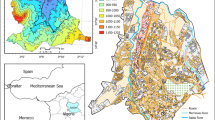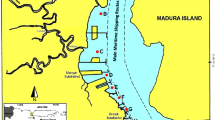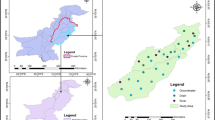Abstract
Background, aim, and scope
The release of trace elements (TE) associated with the development of human activities has accelerated since the nineteenth century, leading to the pollution of river systems. Despite a drastic reduction in industrial inputs in northern Europe, diffuse pollution originating from urban areas still prevents achieving the good status required by the European Water Framework Directive. The objectives of the current study, which is a part of a wider project, were to determine the impact of hydrological dynamics on the total exports of TE from an urban catchment and to develop an assessment tool to evaluate the level of contamination of a catchment based on its specific particulate TE fluxes.
Materials and methods
Accordingly, this research investigated the behavior of TE contamination in a 950 km2 catchment (Orge River, France) showing a strong urbanization gradient in downstream direction. Particulate and dissolved samples were collected in the river during a hydrological year at four stations reflecting the increasing urbanization gradient. Trace element concentrations were measured in the samples using inductively coupled plasma/mass spectrometry (ICP-MS). Daily and annual TE fluxes were calculated at the four stations to evaluate the contribution of urban areas to the total TE exports from the catchment.
Results
The quantification of TE fluxes showed that up to 70% of particulate Cu, Zn, Sb, and Pb exported by the Orge River originated from the urban areas located in the lower catchment portions, especially during average water flow periods characterized by frequent rain events. Moreover, the results show that 50% of the dissolved fluxes of Cu, Zn, and Pb are supplied by urban areas during the entire year, regardless of hydrological conditions, and that the specific contribution of floods to these fluxes (i.e., the June 2016 event) is lower than that in other catchments because of the continuous supply of dissolved metal fluxes to the river in this urbanized environment.
Conclusion
These results underline the need to integrate all hydrological conditions for the management of TE contamination in urban areas and not to focus on storm events only. Finally, based on a literature survey, the ratios of specific fluxes were homogeneous across different highly urbanized catchments, and they could be used as a tool to compare the levels of anthropogenic pressure in these contrasted study sites. This observation demonstrates the similar impacts of societal development on urban river geochemistry worldwide, although they occurred during different time periods.





Similar content being viewed by others
References
Adachi K, Tainosho Y (2004) Characterization of heavy metal particles embedded in tire dust. Environ Int 30:1009–1017. https://doi.org/10.1016/j.envint.2004.04.004
Adamiec E, Jarosz-Krzemińska E, Wieszała R (2016) Heavy metals from non-exhaust vehicle emissions in urban and motorway road dusts. Environ Monit Assess 188:1–11. https://doi.org/10.1007/s10661-016-5377-1
Audry S, Schafer J, Blanc G et al (2004) Anthropogenic components of heavy metal (Cd, Zn, Cu, Pb) budgets in the Lot-Garonne fluvial system (France). Appl Geochem 19:769–786. https://doi.org/10.1016/j.apgeochem.2003.10.002
Ayrault S, Roy-Barman M, Le Cloarec MF et al (2012) Lead contamination of the Seine River, France: geochemical implications of a historical perspective. Chemosphere 87:902–910. https://doi.org/10.1016/j.chemosphere.2012.01.043
Ayrault S, Priadi CR, Le Pape P, Bonté P (2013) Occurrence, sources and pathways of antimony and silver in an urban catchment. In: Rauch S, Morrison G, Norra S, Schleicher N (eds) Urban environment. Springer, Dordrecht, pp 425–435
Barco J, Papiri S, Stenstrom MK (2008) First flush in a combined sewer system. Chemosphere 71:827–833. https://doi.org/10.1016/j.chemosphere.2007.11.049
Becouze-Lareure C, Dembélé A, Coquery M, Cren-Olivé C, Barillon B, Bertrand-Krajewski JL (2016) Source characterisation and loads of metals and pesticides in urban wet weather discharges. Urban Water J 13:600–617. https://doi.org/10.1080/1573062X.2015.1011670
Boyle RW, Jonasson IR (1984) The geochemistry of antimony and its use as an indicator element in geochemical prospecting. J Geochem Explor 20:223–302. https://doi.org/10.1016/0375-6742(84)90071-2
Brown JN, Peake BM (2006) Sources of heavy metals and polycyclic aromatic hydrocarbons in urban stormwater runoff. Sci Total Environ 359:145–155. https://doi.org/10.1016/j.scitotenv.2005.05.016
Charters FJ, Cochrane TA, O’Sullivan AD (2016) Untreated runoff quality from roof and road surfaces in a low intensity rainfall climate. Sci Total Environ 550:265–272. https://doi.org/10.1016/j.scitotenv.2016.01.093
Chen J, Gaillardet J, Louvat P, Huon S (2009) Zn isotopes in the suspended load of the Seine River, France: isotopic variations and source determination. Geochim Cosmochim Acta 73:4060–4076. https://doi.org/10.1016/J.GCA.2009.04.017
Coynel A, Blanc G, Marache A, Schäfer J, Dabrin A, Maneux E, Bossy C, Masson M, Lavaux G (2009) Assessment of metal contamination in a small mining- and smelting-affected watershed: high resolution monitoring coupled with spatial analysis by GIS. J Environ Monit 11:962–976. https://doi.org/10.1039/b818671e
Davide V, Pardos M, Diserens J, Ugazio G, Thomas R, Dominik J (2003) Characterisation of bed sediments and suspension of the river Po (Italy) during normal and high flow conditions. Water Res 37:2847–2864. https://doi.org/10.1016/S0043-1354(03)00133-7
Davis AP, Shokouhian M, Ni S (2001) Loading estimates of lead, copper, cadmium, and zinc in urban runoff from specific sources. Chemosphere 44:997–1009. https://doi.org/10.1016/S0045-6535(00)00561-0
Estebe A, Mouchel JM, Thevenot DR (1998) Urban runoff impacts on particulate metal concentrations. Water Air Soil Pollut 108:83–50. https://doi.org/10.1023/A:1005064307862
Filella M (2011) Antimony interactions with heterogeneous complexants in waters, sediments and soils: a review of data obtained in bulk samples. Earth-Science Rev 107:325–341. https://doi.org/10.1016/j.earscirev.2011.04.002
Froger C, Ayrault S, Evrard O, Monvoisin G, Bordier L, Lefèvre I, Quantin C (2018) Tracing the sources of suspended sediment and particle-bound trace metal elements in an urban catchment coupling elemental and isotopic geochemistry, and fallout radionuclides. Environ Sci Pollut Res 25:28667–28681. https://doi.org/10.1007/s11356-018-2892-3
Froger C, Ayrault S, Gasperi J, Caupos E, Monvoisin G, Evrard O, Quantin C (2019a) Innovative combination of tracing methods to differentiate between legacy and contemporary PAH sources in the atmosphere-soil-river continuum in an urban catchment (Orge River, France). Sci Total Environ 669:448–458. https://doi.org/10.1016/j.scitotenv.2019.03.150
Froger C, Quantin C, Gasperi J, Caupos E, Monvoisin G, Evrard O, Ayrault S (2019b) Impact of urban pressure on the spatial and temporal dynamics of PAH fluxes in an urban tributary of the Seine River (France). Chemosphere 219:1002–1013. https://doi.org/10.1016/j.chemosphere.2018.12.088
Fujiwara F, Rebagliati RJ, Marrero J, Gómez D, Smichowski P (2011) Antimony as a traffic-related element in size-fractionated road dust samples collected in Buenos Aires. Microchem J 97:62–67. https://doi.org/10.1016/j.microc.2010.05.006
Gateuille D, Evrard O, Lefevre I, Moreau-Guigon E, Alliot F, Chevreuil M, Mouchel JM (2014) Mass balance and decontamination times of Polycyclic Aromatic Hydrocarbons in rural nested catchments of an early industrialized region (Seine River basin, France). Sci Total Environ 470–471:608–617. https://doi.org/10.1016/j.scitotenv.2013.10.009
Hasenmueller EA, Criss RE, Winston WE, Shaughnessy AR (2017) Stream hydrology and geochemistry along a rural to urban land use gradient. Appl Geochem 83:136–149. https://doi.org/10.1016/j.apgeochem.2016.12.010
Horowitz AJ (2009) Monitoring suspended sediments and associated chemical constituents in urban environments: lessons from the city of Atlanta, Georgia, USA water quality monitoring program. J Soils Sediments 9:342–363. https://doi.org/10.1007/s11368-009-0092-y
Horowitz AJ, Elrick KA, Smith JJ (2001) Annual suspended sediment and trace element fluxes in the Mississippi, Columbia, Colorado, and Rio Grande drainage basins. Hydrol Process 15:1169–1207. https://doi.org/10.1002/hyp.209
Hu B, Li J, Bi N, Wang H, Yang J, Wei H, Zhao J, Li G, Yin X, Liu M, Zou L, Li S (2015) Seasonal variability and flux of particulate trace elements from the Yellow River: impacts of the anthropogenic flood event. Mar Pollut Bull 91:35–44. https://doi.org/10.1016/j.marpolbul.2014.12.030
Kumar M, Furumai H, Kurisu F, Kasuga I (2009) Understanding the partitioning processes of mobile lead in soakaway sediments using sequential extraction and isotope analysis. Water Sci Technol 60:2085–2091. https://doi.org/10.2166/wst.2009.512
Kumar M, Furumai H, Kurisu F, Kasuga I (2013) Tracing source and distribution of heavy metals in road dust, soil and soakaway sediment through speciation and isotopic fingerprinting. Geoderma 211–212:8–17. https://doi.org/10.1016/j.geoderma.2013.07.004
Lamprea K, Ruban V (2011) Pollutant concentrations and fluxes in both stormwater and wastewater at the outlet of two urban watersheds in Nantes (France). Urban Water J 8:219–231. https://doi.org/10.1080/1573062X.2011.596211
Le Cloarec MF, Bonte PH, Lestel L et al (2011) Sedimentary record of metal contamination in the Seine River during the last century. Phys Chem Earth 36:515–529. https://doi.org/10.1016/j.pce.2009.02.003
Le Gall M, Ayrault S, Evrard O et al (2018) Investigating the metal contamination of sediment transported by the 2016 Seine River flood (Paris, France). Environ Pollut 240:125–139. https://doi.org/10.1016/j.envpol.2018.04.082
Le Pape P, Ayrault S, Quantin C (2012) Trace element behavior and partition versus urbanization gradient in an urban river (Orge River, France). J Hydrol 472–473:99–110. https://doi.org/10.1016/j.jhydrol.2012.09.042
Le Pape P, Ayrault S, Michelot J-L et al (2013) Building an isotopic hydrogeochemical indicator of anthropogenic pressure on urban rivers. Chem Geol 344:63–72. https://doi.org/10.1016/j.chemgeo.2013.02.018
Le Pape P, Quantin C, Morin G et al (2014) Zinc speciation in the suspended particulate matter of an urban river (Orge, France): influence of seasonality and urbanization gradient. Environ Sci Technol 48:11901–11909. https://doi.org/10.1021/es500680x
Lee BC, Matsui S, Shimizu Y, Matsuda T (2005) Characterizations of the first flush in storm water runoff from an urban roadway. Environ Technol 26:773–782. https://doi.org/10.1080/09593332608618508
McKee LJ, Gilbreath AN (2015) Concentrations and loads of suspended sediment and trace element pollutants in a small semi-arid urban tributary, San Francisco Bay, California. Environ Monit Assess 187:499. https://doi.org/10.1007/s10661-015-4710-4
Meybeck M, Lestel L, Bonté P, Moilleron R, Colin JL, Rousselot O, Hervé D, de Pontevès C, Grosbois C, Thévenot DR (2007) Historical perspective of heavy metals contamination (Cd, Cr, Cu, Hg, Pb, Zn) in the Seine River basin (France) following a DPSIR approach (1950-2005). Sci Total Environ 375:204–231. https://doi.org/10.1016/j.scitotenv.2006.12.017
Navratil O, Evrard O, Esteves M, Ayrault S, Lefèvre I, Legout C, Reyss JL, Gratiot N, Nemery J, Mathys N, Poirel A, Bonté P (2012) Core-derived historical records of suspended sediment origin in a mesoscale mountainous catchment: the River Bléone, French Alps. J Soils Sediments 12:1463–1478. https://doi.org/10.1007/s11368-012-0565-2
Neal C, Davies H (2003) Water quality fluxes for eastern UK rivers entering the North Sea: a summary of information from the Land Ocean interaction study (LOIS). Sci Total Environ 314–316:821–882. https://doi.org/10.1016/S0048-9697(03)00086-X
Neal C, Smith CJ, Jeffery HA, Jarvie HP, Robson AJ (1996) Trace element concentrations in the major rivers entering the Humber estuary, NE England. J Hydrol 182:37–64. https://doi.org/10.1016/0022-1694(95)02940-0
Némery J, Mano V, Coynel A, Etcheber H, Moatar F, Meybeck M, Belleudy P, Poirel A (2013) Carbon and suspended sediment transport in an impounded alpine river (Isère, France). Hydrol Process 27:2498–2508. https://doi.org/10.1002/hyp.9387
Nriagu JO (1996) A history of global metal pollution. Science 272:223–224. https://doi.org/10.1126/science.272.5259.223
Ollivier P, Radakovitch O, Hamelin B (2011) Major and trace element partition and fluxes in the Rhône River. Chem Geol 285:15–31. https://doi.org/10.1016/j.chemgeo.2011.02.011
Percot S, Ruban V, Roupsard P, Maro D, Millet M (2016) A new method for assessing the contribution of atmospheric deposition to the stormwater runoff metal load in a small urban catchment. Water Air Soil Pollut 227:1–13. https://doi.org/10.1007/s11270-016-2794-2
Petit JCJ, Schäfer J, Coynel A, Blanc G, Deycard VN, Derriennic H, Lanceleur L, Dutruch L, Bossy C, Mattielli N (2013) Anthropogenic sources and biogeochemical reactivity of particulate and dissolved cu isotopes in the turbidity gradient of the Garonne River (France). Chem Geol 359:125–135. https://doi.org/10.1016/j.chemgeo.2013.09.019
Pistocchi A, Dorati C, Aloe A, Ginebreda A, Marcé R (2019) River pollution by priority chemical substances under the Water Framework Directive: a provisional pan-European assessment. Sci Total Environ 662:434–445. https://doi.org/10.1016/j.scitotenv.2018.12.354
Poulier G, Launay M, Le Bescond C et al (2019) Combining flux monitoring and data reconstruction to establish annual budgets of suspended particulate matter, mercury and PCB in the Rhône River from Lake Geneva to the Mediterranean Sea. Sci Total Environ 658:457–473. https://doi.org/10.1016/j.scitotenv.2018.12.075
Priadi C, Bourgeault A, Ayrault S et al (2011) Spatio-temporal variability of solid, total dissolved and labile metal: passive vs. discrete sampling evaluation in river metal monitoring. J Environ Monit 13:1470. https://doi.org/10.1039/c0em00713g
Resongles E, Freydier R, Casiot C, Viers J, Chmeleff J, Elbaz-Poulichet F (2015) Antimony isotopic composition in river waters affected by ancient mining activity. Talanta 144:851–861. https://doi.org/10.1016/j.talanta.2015.07.013
Revitt DM, Ellis JB (2016) Urban surface water pollution problems arising from misconnections. Sci Total Environ 551–552:163–174. https://doi.org/10.1016/j.scitotenv.2016.01.198
Rouxel O, Ludden J, Fouquet Y (2003) Antimony isotope variations in natural systems and implications for their use as geochemical tracers. Chem Geol 200:25–40. https://doi.org/10.1016/S0009-2541(03)00121-9
Sabin LD, Jeong HL, Stolzenbach KD, Schiff KC (2005) Contribution of trace metals from atmospheric deposition to stormwater runoff in a small impervious urban catchment. Water Res 39:3929–3937. https://doi.org/10.1016/j.watres.2005.07.003
SAGE Orge-Yvette (2011) Actualisation de l’état des lieux et du diagnostic, France
Schneider V (2005) Apports de l’hydrodynamique et de la géochimie à la caractérisation des nappes de l’Oligocène et de l’Eocène et à la reconnaissance de leurs relations actuelles et passées: origine de la dégradation de la nappe de l’Oligocène (sud-ouest du bassin de Paris. PhD Thesis. Paris-Sud University, Paris, France
The European Parlament and the Council of the European Union (2013) Directives of 12 August 2013 amending Directives 2000/60/EC and 2008/105/EC as regards priority substances in the field of water policy. Off J Eur Union 2013:1–17
Thévenot DR, Moilleron R, Lestel L, Gromaire MC, Rocher V, Cambier P, Bonté P, Colin JL, de Pontevès C, Meybeck M (2007) Critical budget of metal sources and pathways in the Seine River basin (1994-2003) for Cd, Cr, Cu, Hg, Ni, Pb and Zn. Sci Total Environ 375:180–203. https://doi.org/10.1016/j.scitotenv.2006.12.008
Van Metre P, Mahler B (2003) The contribution of particles washed from rooftops to contaminant loading to urban streams. Chemosphere 52:1727–1741. https://doi.org/10.1016/S0045-6535(03)00454-5
Van Metre PC, Mesnage V, Laignel B et al (2008) Origins of sediment-associated contaminants to the Marais Vernier, the Seine Estuary, France. Water Air Soil Pollut 191:331–344. https://doi.org/10.1007/s11270-008-9628-9
Vernoux J, Barbier J, Donsimoni M, et al. (1999) Etude hydrogéologique du plateau de Saclay (Essonne), rapport BRGM SGR/IDF R 40840, France
Weigold F, Baborowski M (2009) Consequences of delayed mixing for quality assessment of river water: example Mulde-Saale-Elbe. J Hydrol 369:296–304. https://doi.org/10.1016/j.jhydrol.2009.02.039
Zachmann DW, van der Veen A, Friese K (2013) Floodplain lakes as an archive for the metal pollution in the River Elbe (Germany) during the 20th century. Appl Geochem 35:14–27. https://doi.org/10.1016/j.apgeochem.2013.05.009
Funding
This research was financially supported by Paris-Sud University (PhD grant), the “Initiative de Recherche Stratégique” ACE-ICSEN funded by the University Paris-Saclay, and the Seine River research program PIREN-Seine.
Author information
Authors and Affiliations
Corresponding author
Ethics declarations
Conflicts of interest
The authors declare that they have no conflict interest.
Additional information
Responsible editor: J Patrick Laceby
Publisher’s note
Springer Nature remains neutral with regard to jurisdictional claims in published maps and institutional affiliations.
Electronic supplementary material
ESM 1
(DOCX 2061 kb).
Rights and permissions
About this article
Cite this article
Froger, C., Quantin, C., Bordier, L. et al. Quantification of spatial and temporal variations in trace element fluxes originating from urban areas at the catchment scale. J Soils Sediments 20, 4055–4069 (2020). https://doi.org/10.1007/s11368-020-02766-1
Received:
Accepted:
Published:
Issue Date:
DOI: https://doi.org/10.1007/s11368-020-02766-1




